Introduction: A Haarlem Master of Genre
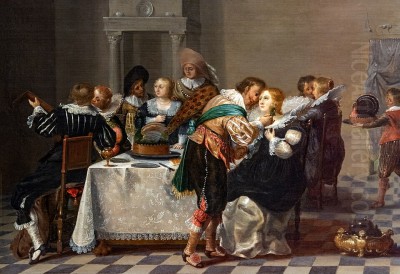
Dirck Hals (1591-1656) stands as a significant figure within the vibrant artistic landscape of the Dutch Golden Age. Born, living, and working primarily in the bustling city of Haarlem, Hals carved a distinct niche for himself as a painter of genre scenes, particularly those depicting the leisurely pursuits of the Dutch bourgeoisie. Though often living in the shadow of his elder brother, the renowned portraitist Frans Hals, Dirck developed his own recognizable style and thematic focus, becoming one of the foremost exponents of the "merry company" picture. His canvases offer a lively window into the social customs, fashions, and everyday enjoyments of seventeenth-century Holland, capturing moments of conviviality, music-making, and celebration with a characteristic charm and colourful palette.
Early Life and Artistic Formation in Haarlem
Dirck Hals was born in Haarlem in 1591. An interesting detail regarding his early life is his baptism into the Protestant faith, which contrasted with the Catholic background often associated with his brother Frans's family origins, reflecting the complex religious tapestry of the Dutch Republic at the time. Haarlem, a major artistic centre, provided a fertile ground for his development. While concrete documentation about his formal training is scarce, it is highly probable that he received instruction or was significantly influenced by his elder brother, Frans Hals. The dynamic brushwork and lively characterization seen in Dirck's work echo aspects of Frans's style, although applied to different subjects and scales.
Beyond the likely influence of his brother, Dirck Hals's artistic development was shaped by other prominent Haarlem artists. Key among these were Esaias van de Velde (c. 1587–1630) and Willem Pieterszoon Buytewech (1591/92–1624). Van de Velde, initially known for his innovative landscape paintings, also played a role in the early development of Dutch genre painting, depicting elegant figures in outdoor settings. Buytewech, often dubbed "Geestige Willem" (Witty Willem), was a master draftsman and painter who specialized in depicting fashionable young people in interior and exterior scenes, effectively popularizing the "merry company" theme that Dirck Hals would make his own. The influence of these artists is evident in Dirck's choice of subject matter, his attention to contemporary fashion, and his compositional arrangements.
The World of the Merry Company
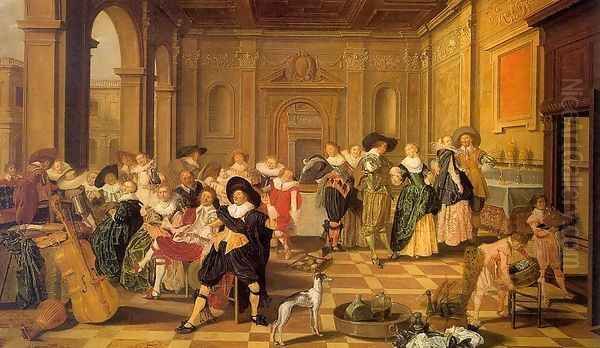
Dirck Hals dedicated much of his career to the "merry company" (geselschapje) genre. These paintings typically depict groups of well-to-do men and women engaged in various forms of leisure and entertainment. His canvases are populated with figures conversing, flirting, playing musical instruments (lutes, violins, virginals were common), dancing, playing games, dining, and drinking wine. The settings vary from modestly furnished domestic interiors to elegant rooms, garden terraces, or outdoor pavilions.
These scenes reflected the growing prosperity and confidence of the Dutch Republic's urban elite. The subjects were often young, fashionably dressed burghers enjoying the fruits of economic success and relative peace. Hals captured the lighthearted atmosphere of these gatherings, focusing on the interactions and the overall mood rather than complex narratives or overt moralizing, although interpretations of underlying meanings continue to be debated by art historians. His works celebrate sociability and the pleasures of everyday life, providing valuable visual documentation of the era's social customs and material culture.
Artistic Style and Technique
Dirck Hals developed a distinctive artistic style characterized by bright colours, a fluid, relatively loose brushstroke, and a keen eye for detail, particularly in rendering clothing and textiles. While perhaps lacking the sheer bravura and psychological depth found in the portraits of his brother Frans, Dirck's technique was perfectly suited to his chosen subject matter. His application of paint is often lively and energetic, contributing to the animated feel of his scenes.
He typically worked on a relatively small scale, often painting on wood panels. His interior settings are sometimes described as simply rendered, serving primarily as backdrops for the figures. The emphasis is clearly on the human element: the expressions, gestures, and postures of the individuals within the group. Hals excelled at arranging his figures in relaxed, seemingly informal groupings, creating a sense of spontaneous interaction. The rich fabrics, elaborate collars, plumed hats, and stylish attire of his subjects are depicted with care, highlighting the importance of fashion in seventeenth-century Dutch society. His use of colour is often bold and decorative, enhancing the cheerful and festive mood of his paintings.
Spotlight on Key Works
Dirck Hals's oeuvre includes numerous paintings that exemplify his focus on merry companies and related genre themes. Several stand out as representative of his style and subject matter:
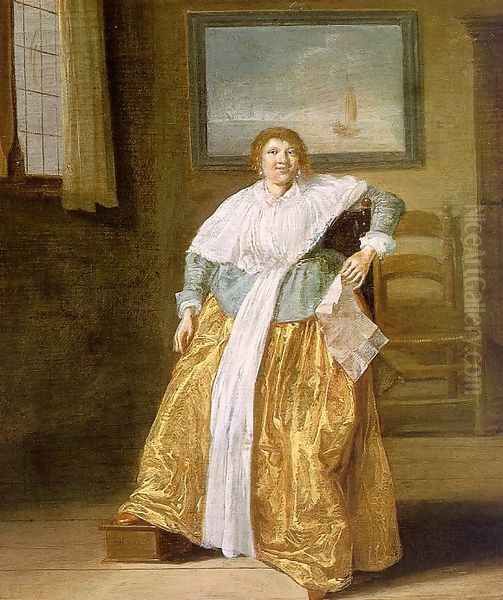
Vanvestenav (Eve of Lent, or Shrove Tuesday) (1616-17): This relatively early work depicts the boisterous celebrations associated with Vastenavond, the day before Lent began. It showcases Hals's early interest in capturing festive traditions and group dynamics, likely influenced by artists like Buytewech who also depicted such popular themes. The scene captures the spirit of carnival and communal revelry characteristic of the period.
Merry Company on a Terrace (1625): Housed in the National Gallery, London, this painting is a quintessential example of Hals's outdoor merry companies. It shows a group of elegantly dressed young men and women enjoying music and refreshments on a terrace overlooking a garden. The work embodies the ideal of refined rural pleasure enjoyed by the urban elite, showcasing contemporary fashion and social interaction in a relaxed, sunlit setting.
A Party at Table (1626): This work likely depicts an indoor gathering focused around a meal. Typical of Hals, it would feature young figures engaged in conversation, perhaps with musical instruments nearby or glasses raised in a toast. Such scenes often subtly explored themes of courtship and the pleasures of the senses, reflecting the social life of prosperous Dutch citizens.
A Banquet Scene in a Renaissance Hall (1628): This painting places the familiar theme of a social gathering within a more imposing architectural setting, possibly indicating a collaboration or influence from architectural painters. It highlights the taste for grandeur and the staging of social life within impressive interiors during the period. The detailed depiction of the hall contrasts with some of Hals's simpler backgrounds.
Merry Company (c. 1630): This title applies to many of Hals's works, but a typical example from this period would feature a lively mix of activities – perhaps dancers moving to music played by seated musicians, while others engage in conversation or enjoy drinks. These compositions skillfully balance multiple figures and activities, creating a vibrant snapshot of social entertainment.
Seated Woman with a Letter (1633): While still a genre scene, this work offers a more intimate focus than the larger group paintings. It depicts a solitary woman, seated, interacting with a letter – perhaps reading it, perhaps having just torn it, as suggested by some interpretations. This theme, popular in Dutch art, touched upon communication, privacy, and often hinted at narratives of love, longing, or perhaps broken promises, reflecting contemporary interest in personal emotions.
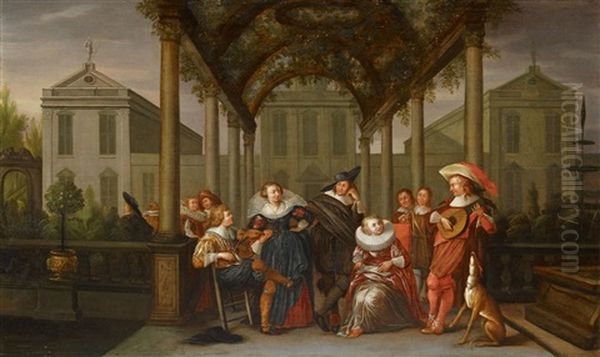
Vornehme Gesellschaft im Freien (Elegant Company Outdoors) (17th Century): This painting, known through provenance records including a significant 1933 auction price, depicts an elegant outdoor gathering, likely a picnic or garden party. The description suggests a scene of upper-middle-class leisure, possibly set within a Baroque-style garden, emphasizing luxury and the enjoyment of nature combined with social refinement.
These works, varying slightly in setting and specific activity, consistently showcase Dirck Hals's talent for capturing the spirit of convivial gatherings, his vibrant colour sense, and his detailed observation of contemporary Dutch life and fashion.
Professional Life and Collaborations
Dirck Hals pursued a steady career as a professional painter in Haarlem. His membership in the city's Guild of Saint Luke, the professional organization for painters and other craftsmen, is documented from 1627 until his death, indicating his established status within the local art community. He appears to have found a ready market for his specific brand of genre painting.
An important aspect of his professional activity was his collaboration with the architectural painter Dirck van Delen (1604/05–1671). Van Delen specialized in creating meticulously rendered imaginary architectural spaces – palace interiors, church views, and courtyards, often in a Renaissance or Baroque style. From around the early 1630s (sources vary slightly, mentioning periods like 'until 1634' or '1634-1636'), Hals collaborated with Van Delen, painting the small figures (staffage) that populated these grand architectural settings. This partnership combined Van Delen's skill in perspective and architectural detail with Hals's facility in depicting lively human figures, resulting in elaborate and popular compositions.
On the personal front, Dirck Hals married Annet Jans around 1620 or 1621. The couple had seven children, suggesting a stable family life alongside his artistic pursuits. He remained in Haarlem throughout his life, passing away there in 1656.
Context: Contemporaries and Connections
Dirck Hals operated within a rich network of artists in Haarlem and the broader Dutch Republic. His most obvious connection was to his brother, Frans Hals (c. 1582/83–1666), whose influence, particularly in lively characterization and brushwork, is discernible. His primary influences in the genre field were Esaias van de Velde and Willem Buytewech. His collaborator Dirck van Delen represents another significant professional link.
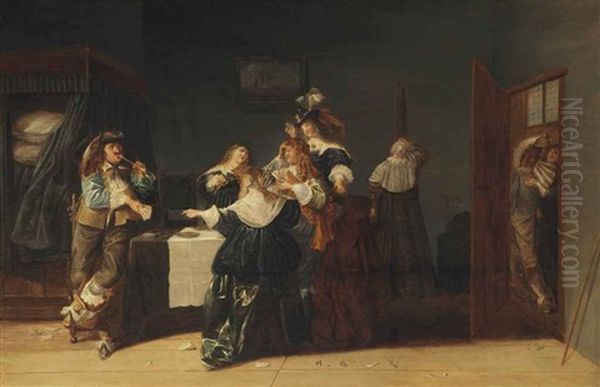
Haarlem itself was home to numerous other talented painters during this period. Judith Leyster (1609–1660), herself a master of genre scenes and portraits (and possibly a student of Frans Hals or influenced by Dirck), worked in a lively style, sometimes depicting similar themes of music-making and merry companies. Her husband, Jan Miense Molenaer (c. 1610–1668), was also a prolific genre painter active in Haarlem, often depicting scenes with a greater degree of narrative or humorous anecdote.
For contrast, one can look at other Haarlem contemporaries like Adriaen Brouwer (1605/06–1638), a Flemish artist who worked in Haarlem for a time and specialized in vigorous, often rough depictions of peasant life, taverns, and smokers – a different social stratum than Hals typically portrayed. Similarly, Adriaen van Ostade (1610–1685) and his brother Isaac van Ostade (1621–1649) were Haarlem masters known primarily for their sympathetic depictions of peasant interiors and village life.
Looking beyond Haarlem, other Dutch artists explored similar "merry company" or related genre themes. In Amsterdam, Pieter Codde (1599–1678) and Willem Duyster (1599–1635) were known for their elegant interior scenes, often featuring soldiers in guardrooms (kortegaardjes) or refined social gatherings, sometimes with a smoother finish and cooler palette than Hals. Jacob Duck (c. 1600–1667), active mainly in Utrecht and The Hague, also frequently painted merry companies and guardroom scenes, often with a distinct elegance and attention to rich fabrics. The great Leiden-born master Jan Steen (1626–1679), who also worked in Haarlem for periods, brought unparalleled narrative wit and psychological insight to his bustling, often chaotic, scenes of everyday life and celebration. Dirck Hals's work also appears to have influenced later artists, such as Wouter van Beers. This network of contemporaries, rivals, and collaborators highlights the dynamism and specialization within Dutch Golden Age painting.
Reception Through Time
The historical assessment of Dirck Hals's art has evolved considerably. During his lifetime and in the period immediately following, while his works were clearly popular with buyers, he may not have been regarded as being in the absolute first rank of Dutch painters. Some later critics perhaps found his technique less sophisticated or his subject matter somewhat repetitive compared to artists exploring more complex narratives or deeper psychological states. His work was sometimes characterized as charming but technically somewhat simple or superficial.
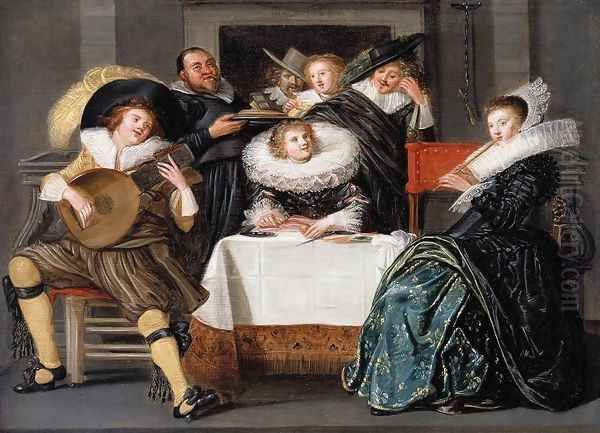
However, a significant reappraisal began in the later nineteenth century. Artists associated with Impressionism and subsequent movements found much to admire in the work of seventeenth-century Dutch painters, including Dirck Hals and especially his brother Frans. They were drawn to the visible, fluid brushwork, the capture of fleeting moments, and the depiction of everyday life. Dirck's lively handling of paint and his colourful palette resonated with these later artistic sensibilities, contributing to a renewed appreciation of his skills.
In modern art history, Dirck Hals is firmly recognized as a key figure in the development and popularization of the "merry company" genre. While acknowledging his debt to predecessors like Buytewech and the influence of his brother, scholars appreciate his specific contribution: the sheer number of works he produced in this vein, his consistent focus on cheerful sociability, and his skill in creating appealing, decorative compositions. There remains some scholarly discussion regarding the potential underlying meanings of his works – whether they are straightforward celebrations of pleasure or contain subtle moral warnings about excess, a common feature in Dutch genre painting. Regardless of interpretation, his paintings are valued for their historical insight into the leisure activities, fashion, and social environment of the Dutch Golden Age.
Conclusion: A Legacy of Sociability
Dirck Hals occupies a specific and important place in the grand narrative of Dutch Golden Age art. As a dedicated specialist in the "merry company" genre, he provided his contemporaries with delightful glimpses into the world of prosperous urban leisure. His paintings, characterized by vibrant colours, lively figures, and meticulous attention to the details of fashion and setting, capture the optimistic spirit and burgeoning social life of seventeenth-century Haarlem.
Though perhaps overshadowed historically by his famous brother Frans, and influenced significantly by pioneers like Esaias van de Velde and Willem Buytewech, Dirck Hals developed a distinct and recognizable artistic personality. His collaborations, particularly with Dirck van Delen, further demonstrate his integration into the artistic networks of his time. Initially somewhat overlooked by later art historical accounts, his work found renewed appreciation for its painterly qualities and its value as a social document. Today, Dirck Hals is recognized for his charming and skillful depictions of conviviality, leaving behind a legacy of images that continue to evoke the sociable pleasures of a bygone era. His canvases remain a testament to the Dutch Golden Age's fascination with observing and celebrating everyday life.